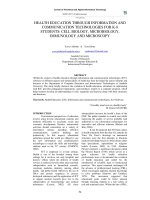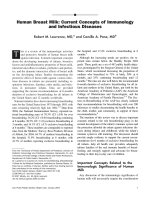Kaplan USMLE-1 (2013) - Immunology and Microbiology
Bạn đang xem bản rút gọn của tài liệu. Xem và tải ngay bản đầy đủ của tài liệu tại đây (47.86 MB, 540 trang )
�APLA'Y
MEDICAL
USMLE™. Step 1
Immunology and Microbiology
Lecture Notes
BK4033J
•usMLE™ is a joint program of the Federation of State Medical Boards of the United States and the National Board of Medical Examiners.
©2013 Kaplan, Inc
.
All rights reserved. No part of this book may be reproduced in any form, by photostat,
microfilm, xerography or any other means, or incorporated into any information retrieval
system, electronic or mechanical, without the written permission of Kaplan, Inc.
Not for resale.
Author
Kim Moscatello, Ph.D.
Professor of Microbiology and Immunology
Lake Erie College of Osteopathic Medicine
Erie, PA
Contributors
Thomas F. Lint, Ph.D.
Professor of Immunology and Microbiology
Rush Medical College
Chicago, IL
Christopher C. Keller, Ph.D.
Associate Professor of Microbiology and Immunology
Lake Erie College of Osteopathic Medicine
Erie, PA
Previous contributions by Mary Ruebush, Ph.D.
Contents
Preface
.
.
.
.
.
.
.
.
.
.
.
.
.
.
.
.
.
.
.
.
.
.
.
.
.
.
.
.
.
.
.
.
vii
.
.
.
.
.
.
.
.
.
.
.
.
.
.
.
.
.
.
.
.
.
.
.
.
.
.
.
.
.
.
.
.
.
.
.
.
.
.
.
.
.
.
.
.
.
.
.
.
.
.
.
.
.
.
.
.
.
.
.
.
.
.
.
.
.
.
.
.
.
.
.
.
.
.
.
.
.
.
.
.
.
.
.
.
.
.
.
.
.
.
.
.
.
.
.
.
.
.
.
.
.
.
.
.
.
.
.
.
.
.
.
.
.
.
.
.
.
.
.
.
.
.
.
.
.
.
.
.
.
.
.
.
.
.
.
.
.
.
.
.
.
.
.
.
.
.
.
Section I: Immunology
Chapter 1: Overview of the Immune System
Chapter 2: Cells of the Immune System
.
Chapter 3: The Selection of Lymphocytes
.
.
.
.
.
.
.
.
.
.
.
.
.
.
.
Chapter 4: Lymphocyte Recirculation and Homing
Chapter 5: The First Response to Antigen
.
.
.
.
.
.
.
.
.
Chapter 6: The Processing and Presentation of Antigen
.
Chapter 7: The Generation of Humoral Effector Mechanisms
.
Chapter 8: The Generation of Cell-Mediated Effector Mechanisms
Chapter 9: The Generation of Immunologic Memory
Chapter 10: Vaccination and lmmunotherapy..
.
.
.
.
.
.
.
.
.
.
.
.
.
.
.
.
.
.
.
..
.
.
.
.
.
3
7
23
33
39
51
67
. 89
.
.
.
.
.
.
.
.
.
.
.
.
.
.
.
.
.
.
.
101
107
Chapter 11: Immunodeficiency Diseases. ......................... 117
.
Chapter 12: Acquired Immunodeficiency Syndrome ................ 131
.
Chapter 13: Diseases Caused by Immune Responses:
Hypersensitivity and Autoimmunity .................... 141
Chapter 14: Transplantation Immunology
.
.
.
.
.
.
.
.
.
.
Chapter 15: Laboratory Techniques in Immunology .
.
.
.
.
.
.
.
.
.
.
.
.
.
.
.
.
.
.
.
.
.
.
.
.
.
.
.
.
.
.
.
159
..171
Appendix I: CD Markers ........................................ 185
Appendix II: Cytokines .
.
.
.
.
.
.
.
.
.
.
.
.
.
.
.
.
.
.
.
.
.
.
.
.
.
.
.
.
.
.
.
.
.
.
.
.
.
.
.
.
187
� MEDICAL
V
Appendix Ht Mhes\on Mo\ecu\es
.
.
.
.
.
.
.
.
.
.
.
.
.
.
.
.
.
.
.
.
.
.
.
.
.
Appendix IV: Mechanisms of Resistance to Microbial Infections
.
.
.
.
.
.
.
.
.
.
.
.
.
.
191
193
Section II: Microbiology
Chapter 1: General Microbiology
.
.
.
.
.
.
Chapter 2: Medically Important Bacteria
.
.
.
.
.
.
.
.
.
.
.
.
.
.
.
.
.
.
.
.
.
.
.
.
.
.
.
.
.
.
.
.
.
.
.
.
.
.
.
.
.
.
.
.
.
.
.
.
.
.
.
.
.
.
.
.
.
.
.
.
.
.
.
.
.
.
.
.
.
.
.
.
.
.
.
Chapter 3: Microbial Genetics/Drug Resistance
Chapter 4: Medically Important Viruses
Chapter s: Medically Important Fungi
Chapter 6: Medical Parasitology
.
.
.
Vi
� MEDICAL
.
.
.
.
.
.
.
.
.
.
.
.
.
.
.
.
.
.
.
.
.
.
.
.
.
.
.
.
.
.
.
.
.
.
.
.
.
.
.
.
.
.
.
.
.
.
.
.
.
.
.
.
.
.
.
.
.
.
.
.
.
.
.
.
.
.
.
.
.
.
.
.
.
.
.
.
.
.
.
.
.
.
.
.
.
.
.
.
.
.
.
.
.
.
.
.
.
.
.
.
.
.
.
.
.
.
.
.
.
.
.
.
.
.
.
.
.
.
.
.
.
.
.
.
.
.
.
.
.
.
.
.
.
.
.
.
.
.
.
.
.
.
.
.
.
.
.
.
.
.
.
.
.
.
.
.
.
.
.
.
.
.
.
.
.
.
.
.
.
.
.
.
.
.
.
.
.
.
.
.
.
.
.
.
.
.
.
.
.
.
.
.
.
.
.
.
.
.
.
.
.
.
.
.
.
.
.
.
.
.
.
.
.
.
.
.
.
.
.
.
.
.
.
.
.
.
.
.
.
.
.
.
Chapter 8: Comparative Microbiology
Index
.
.
Chapter 7: Clinical Infectious Disease
Chapter 9: Flow Charts/Clue Sheets
.
199
209
311
347
419
435
457
483
499
515
Preface
These 7 volumes of Lecture Notes represent the most-likely-to-be-tested material on
the current USMLE Step 1 exam. Please note that these are Lecture Notes, not review
books. The Notes were designed to be accompanied by faculty lectures-live, on video,
or on the web. Reading them without accessing the accompanying lectures is not an
effective way to review for the USMLE.
To maximize the effectiveness of these Notes, annotate them as you listen to lectures.
To facilitate this process, we've created wide, blank margins. While these margins are
occasionally punctuated by faculty high-yield "margin notes;' they are, for the most
part, left blank for your notations.
Many students find that previewing the Notes prior to the lecture is a very effective
way to prepare for class. This allows you to anticipate the areas where you'll need to
pay particular attention. It also affords you the opportunity to map out how the infor
mation is going to be presented and what sort of study aids (charts, diagrams, etc.) you
might want to add. This strategy works regardless of whether you're attending a live
lecture or watching one on video or the web.
Finally, we want to hear what you think. What do you like about the Notes? What could
be improved? Please share your feedback by e-mailing us at
Thank you for joining Kaplan Medical, and best ofluck on your Step 1 exam!
Kaplan Medical
� MEDICAL
vii
SECTION
Immunology
1
Overview of the Im m une System
What the USMLE Requires You To Know
•
Com ponents of the i n n ate and adaptive i m m une responses
•
Attributes of i n n ate and adaptive im m u n e responses
•
I nteractions between in nate and adaptive i m m un e responses
The immune system is designed to produce a coordinated response to the introduc
tion of foreign substances or antigens into the body. It is organizationally divided
into two complementary arms: the innate (or native or natural) immune system and
the adaptive (or acquired or specific) immune system.
In
a Nutshell
The i m m une system has two arms:
•
I n nate
•
Adaptive
Innate immunity provides the body's early line of defense against microbial invaders.
It comprises 4 types of defensive barriers:
•
Anatomic or physical (skin, mucous membranes)
•
Phagocytic (monocytes, neutrophils, macrophages)
•
Inflammatory events
• Physiologic (temperature, pH, and chemicals such as lysozyme, comple
ment, and some interferons)
Innate immune defenses have in common that they:
•
Are present intrinsically with or without previous stimulation
•
Have limited specificity for shared structures of microbes
•
Are not enhanced in activity by repeated exposure
•
Have limited diversity of expression
Once the barriers of the innate immune response have been breached, the adaptive
immune response is activated in an antigen-specific fashion to provide for the elimi
nation of antigen and lasting protection from future challenge. The components of
the adaptive immune system are:
•
Lymphocytes (T cells and B cells) and plasma cells (end cells of
B-lymphocyte differentiation)
•
Antigen-presenting cells (macrophages, B cells, and dendritic cells)
Adaptive immune defenses have in common that they are:
•
Specific for particular antigens and are specialized to provide the best protection
•
Diverse in their specificity
•
Enhanced with each repeated exposure (express immunologic memory)
•
Capable of self/non-self recognition
In
a Nutshell
The I n nate Arm (Anatomic, Physiologic,
Phagocytic, Inflammatory)
•
Present intrinsically
•
Nonspecific
•
No memory
•
Lim ited diversity
In
a Nutshell
The Adaptive Arm (Lym phocytes and Their
Products)
•
I n d ucible
•
Specific
• Memory
•
Extensive d iversity
•
Self versus non-self distinction
•
Self-limiting
• Self-limiting
�
M E DICAL
3
Section I • Immunology
These features of adaptive immunity are designed to give the individual the best pos
sible defense against disease. Specificity is required, along with memory, to protect
against persistent or recurrent challenge. Diversity is required to protect against the
maximum number of potential pathogens. Specialization of function is necessary so
that the most effective defense can be mounted against diverse challenges. The ability
to distinguish between invaders and one's own cells and tissues (self versus non-self)
is vital in inhibiting a response to one's own cells (autoimmunity). Self-limitation
allows the system to return to a basal resting state after a challenge to conserve energy
and prepare for the challenge by new microbes.
Table l-1-1. Comparison of Innate and Adaptive Immunity
Characteristics
Innate
Adaptive
Specificity
For structures shared by
groups of m icrobes
For specific antigens
of m icrobial and
non microbial agents
Diversity
Limited
High
Memory
No
Yes
Self-reactivity
No
No
Components
Anatomic and
chemical barriers
Skin, m ucosa, chemicals
(lysozyme, interferons
and �), temperature, pH
Lymp h nodes, spleen,
m ucosal-associated
lymphoid tissues
Blood proteins
Complement
Antibodies
Cells
Phagocytes and natural
killer (NK) cells
Lym p h ocytes (other than
NK cells)
a
The innate and adaptive arms of the immune response do not operate independently
of one another.
In a Nutshell
• Antibodies and complement en hance
p hagocytosis.
• Anti bodies activate complement.
• Cytokin es stim ulate adaptive and in
nate responses.
• Phagocytic cells process and display antigen to facilitate stimulation of spe
cific T lymphocytes.
• Macrophages secrete immunoregulatory molecules (cytokines), which help
trigger the initiation of specific immune responses.
• T lymphocytes produce cytokines, which enhance the microbicidal activities
of phagocytes.
• Antibodies produced by plasma cells bind to pathogens and activate the
complement system to result in the destruction of the invaders.
• Antibodies produced by B lymphocytes bind to pathogens and assist with
phagocytosis (opsonization).
4
�
M EDICAL
Chapter :1. • Overview of the Immune System
Innate Barriers
assist phagocytosis
(opsonization + chemotaxis)
Anatomic
(Skin, mucosa, cilia)
assist phagocytosis
(opsonization)
Cellular:
Neutrophils
Macrophages
l
Cytokines
I
..__...L
Chemical
(acid, lysozyme,
complement)
activate
J
;-1
�
activate
Acquired Immunity
B-lymphocytes
�
l
T-lymphocytes
vate
Antibodies
activate
activate
l
!
Cytokines
Cells of
cell-mediated
immunity
Figure 1-1 -1 . Interaction Between Innate and Adaptive Immune Responses
Chapter Summary
•
The i m m une system has two arms, innate and adaptive.
•
The i n nate arm is a barrier system consisting of anatomic, p h ysiologic,
p hagocytic, or inflammatory components.
•
The i n nate arm is present intri nsically, has limited specificity and diversity, and
is not enhanced by repeated exposure.
•
The adaptive arm consists of T and B lym phocytes and antigen-presenting cells.
•
Adaptive immune responses a re specific, diverse, self-limiting, capable of self
versus non-self recognition, and display m emory.
•
The i n nate and adaptive arms interact with and augm e nt each other through
soluble substances such as antibodies, complement, and cytokines.
�
M E D I CA L
5
Cells of the Im m une System
2
What the USMLE Requires You To Know
•
The cells of the i m mune system , their origin, tissue distri bution, and function
•
The structure and function of antigen-recognition m olecules of B and
T lym phocytes
•
The make-up of the signal transduction complex of B and T lym phocytes
•
The basic mechanism of gene-segment rearrangement to generate receptor diversity
ORIGI N
The cells of the immune system arise from a pluripotent stem cell in the bone mar
row. Differentiation of this cell will occur along one of two pathways, giving rise to
either a common lymphoid progenitor cell or a common myeloid progenitor cell. The
common lymphoid progenitor cell gives rise to B lymphocytes, T lymphocytes, and
natural killer (NK) cells. The myeloid progenitor gives rise to erythrocytes, platelets,
basophils, mast cells, eosinophils, neutrophils, monocytes, macrophages, and den
dritic cells.
In
a Nutshell
• The lym p h oid progenitor m a kes B
cells, T cells, and NK cells.
• The m yeloid progenitor m a kes red
blood cells, platelets, basophils, mast
cells, eosinophils, neutrophils, mono
cytes, macrophages, and dendritic
cells.
�
M E D I CA L
7
Section I • Immunology
�
� --;:,
.
ln Thymus
per T lymphocyte
T progenitor
Thymocyte
.......
Cytotoxic T lymphocyte
Lymphoid
stem cell
Pluripotent stem cell
B Lymphocyte
B progenitor
/
*,.
/---------�------� @ -.......,:
�
;----
Granulocyte
Monocyte
progenitor
G M-CSF, IL-3
Plasma cell
�
Monocyte
Neutrophil
:�
e nd ltl cell
'"
Macrophage
Mast cell
Basophil
progenitor
Basophil
IL-1 1
--.
�
��
@�
��
,�
Platelets
-�·
Erythroid progenitor
Erythrocytes
Figure 1-2-1 . The Ontogeny of Immune Cells
8
�
M E D I CA L
Chapter 2 • Cells of the Immune System
In a Nutshell
FUNCTION
The white blood cells of both myeloid and lymphoid stem cell origin have spe
cialized functions in the body once their differentiation from the bone mar
row is complete. Cells of myeloid heritage perform relatively stereotyped
responses and are thus considered members of the innate branch of the im
mune system. Cells of the lymphoid lineage perform finely tuned, antigen
specific roles in immunity.
• Myeloid cells are in the innate branch.
• Lym phoid cells (except NK cells) are in
the adaptive branch.
Table 1-2-1. Myeloid Cells
Myeloid Cell
Tissue Location
Identification
Function
Monocyte
Bloodstream,
0-900/µL
Kidney bean
shaped n ucleus,
CD14 positive
Phagocytic, d iffer
entiate into tissue
macrophages
Macro p hage
Tissues
Ruffled mem
brane, cytoplasm
with vacuoles and
vesicles, CD14
positive
Phagocytosis,
secretion of cyto
kines
Dendritic cell
Epith elia, tissues
Long cytoplasmic
arms
Antigen capture,
transport, and
presentation
Neutrophil
Bloodstream,
1,800-7,800/µL
Multilobed
n ucleus; small
light p i n k to purple
granules
Phagocytosis and
activation of bactericidal mechan isms
Eosinophil
Bloodstream,
0-45 0/µL
Bilobed nucleus,
large pink granules
Killing of antibodycoated parasites
�
(Continued)
�
M E D I CA L
9
Section I • Immunology
Table 1-2-1. Myeloid Cells (continued)
In a Nutshell
• B lymphocytes are generated and
mature i n the bone m arrow.
• T lym p h ocytes undergo maturation in
the thymus.
• NK cells a re large, granular
lymphocytes.
Myeloid Cell
Tissue Location
Identification
Function
Basophil
B loodstream,
0-200/µL
Bilobed nucleus,
large blue gran
ules
Non p hagocytic,
release p harma
cologically active
substances during
allergic responses
Mast cell
Tissues, m ucosa,
and epithelia
Small n ucleus,
cytoplasm packed
with large blue
gran ules
Release of gran
ules containing
hista mine, etc.,
during a llergic
responses
Although lymphocytes in the bloodstream and tissues are nearly morphologically indis
tinguishable at the light microscopic level, we now know that there are several distinct
but interdependent lineages of these cells: B lymphocytes, so called because they com
plete their development in the bone marrow, and T lymphocytes, so called because
they pass from their origin in the bone marrow into the thymus, where they complete
their development. Both have surface membrane-receptors designed to bind specific
antigens. The third type of lymphocyte, the natural killer (NK) cell, is a large, granular
lymphocyte that recognizes certain tumor and virus-infected cells (See Chapter 8).
Table 1-2-2. Lymphoid Cells
Lymphoid Cell
Location
Identification
Function
Lymp hocyte
Bloodstream ,
1 ,000-4,000/µl;
lym p h nodes,
spleen,
subm ucosa, and
epithelia
Large, dark n ucleus,
small rim of
cytoplasm
B cells produce
antibody
B cells - CD19, 20, 21
T cells - CD3
TH cells -CD4
CTLs - CD8
Natural killer
(NK) lym p hocyte
Bloodstream,
::;10% of
lym p hocytes
Lym phocytes with
large cytoplasmic
granules
CD16 + CD56 positive
Plasma cell
10
�
M E DICAL
Lymp h nodes,
spleen, mucosal
associated
lymphoid tissues,
and bone m arrow
Small dark n ucleus,
intensely staining
Golgi apparatus
T h elper cells
regulate immune
responses
Cytotoxic T cells
(CTLs) kill altered
or infected cells
Kill tumor/virus
cell targets or
antibody-coated
target cells
End cell of B-cell
differentiation,
produce antibody
Chapter 2 • Cells of the Immune System
ANTIGEN RECOGNITION MOLECULES OF LYMPHOCYTES
Each of the cells of the lymphoid lineage is now clinically identified by the character
istic surface molecules that they possess, and much is known about these structures,
at least for B and T cells. The B lymphocyte, in its mature ready-to-respond form (the
naive B lymphocyte), wears molecules of two types of antibody or immunoglobulin
called IgMand IgD embedded in its membrane. The naive T cell wears a single type of
genetically related molecule, called the T-cell receptor (TCR), on its surface. Both of
these types of antigen receptors are encoded within the immunoglobulin superfamily
of genes and are expressed in literally millions of variations in different lymphocytes
as a result of complex and random rearrangements of the cells' DNA.
Alpha
Chain
Mature B Lymphocyte
In
a Nutshell
• The naive B-cell antigen receptors are
lgM and lgD.
• Th e T-cell antigen receptor is made of
and � chains.
a
Beta
Chain
Mature T Lymphocyte
Figure 1-2-2. Antigen Receptors of Mature Lymphocytes
The antigen receptor of the B lymphocyte, or membrane-bound immunoglobulin,
is a 4-chain glycoprotein molecule that serves as the basic monomeric unit for each of
the distinct antibody molecules destined to circulate freely in the serum. This mono
mer has two identical halves, each composed of a long, or heavy chain (µfor immu
noglobulin [lg] Mand 8 for IgD), and a shorter, light chain (Kor A). A cytoplasmic
tail on the carboxy-terminus of each heavy chain extends through the plasma mem
brane and anchors the molecule to the cell surface. The two halves are held together
by disulfide bonds into a shape resembling a "Y;' and some flexibility of movement is
permitted between the halves by disulfide bonds forming a hinge region.
On the N-terminal end of the molecule where the heavy and light chains lie side by
side, a "pocket" is formed whose 3-dimensional shape will accommodate the non
covalent binding of one, or a very small number, of related antigens. The unique
3-dimensional shape of this pocket is called the idiotype of the molecule, and al
though two classes (isotypes) of membrane immunoglobulin (IgM and IgD) are
co expressed (defined by amino acid sequences toward the carboxy terminus of the
molecule), only one idiotype or antigenic specificity is expressed per cell (although
in multiple copies). Each human individual is capable of producing hundreds of mil
lions of unique idiotypes.
In
a N utshell
• Membra n e-bound lg has two h eavy
and two light chains.
• A "hinge" region joins the heavy
chains.
•
Th e idiotype of the molecule resides
i n the N-terminal pocket of h eavy and
light chai ns.
• The isotype of the molecule is
determ i n ed by domains toward the
(-term i n us .
�
M E DICAL
11
Section I
•
Immunology
Antigen-binding site
!
N
Determines
idiotype
Heavy chain
·.
.
Hinge
---
:
•,
.
.
.
.
.
S --S
l
s--s
sI
sI
C 2:
:
H
s
s
Determines
isotype
s
c 3 :
H S
c
c
Figure 1-2-3. B-Lymphocyte Antigen Recognition Molecule
(Membrane-Bound lmmunoglobulin)
In a Nutshell
•
•
The T-cell receptor has
chains.
a/�
It binds peptides presented by
an ti gen-presen t i ng ce lls .
•
The molecule is rigid.
•
The molecule is always
cell-bound.
In a N utshell
B cells recognize unprocessed
a ntigens.
•
•
T cells recognize cell-bound peptides.
In a N utshell
•
•
The B-cell signal transduction com plex
is
g- CD19, and CD21.
lg-a, l �
.
The T-cell signal transduction com plex
is CD3.
12
�
M E D I CAL
The antigen receptor of the T lymphocyte is composed of two glycoprotein chains that
are similar in length and are thus designated a and 13 chains. On the carboxy-terminus
of a/13 chains, a cytoplasmic tail extends through the membrane for anchorage. On the
N-terminal end of the molecule, a groove is formed between the two chains, whose
three-dimensional shape will accommodate the binding of a small antigenic peptide
presented on the surface of an antigen-presenting cell (macrophage, dendritic cell, or B
lymphocyte). This groove forms the idiotype of the TCR. Notice that there is no hinge
region present in this molecule, and thus its conformation is quite rigid.
The membrane receptors of B lymphocytes are designed to bind unprocessed an
tigens of almost any chemical composition, whereas the TCR is designed to bind
only cell-bound peptides. Also, although the B-cell receptor is ultimately modified
to circulate freely in the plasma as secreted antibody, the TCR is never released from
its membrane-bound location.
In association with these unique antigen-recognition molecules on the surface ofB and T
cells, accessory molecules are found whose function is in signal transduction. Thus, when
a lymphocyte binds to an antigen complementary to its idiotype, a cascade of messages
transferred through its signal transduction complex will culminate in intracytoplasmic
phosphorylation events, which will activate the cell. In theB cell, this signal transduction
complex is composed of two single-chain irnmunoglobulin relatives known as lg-a and
Ig-13 and two other molecules designated CD (cluster of differentiation) 19 and 21. In the
T cell, the signal transduction complex is a multichain structure called CD3.
Chapter 2 • Cells of the Immune System
: : : : f:t: :·
g
lg-� l -a
: 1: : : :
11
::: :: :::
lg-a lg-�
II
CD21
CD1 9
T-Cell Signal Transduction Complex
8-Cell Signal Transduction Complex
Figure 1-2-4
Table 1-2-3. Comparison of B- and T-Lymphocyte Antigen Receptors
Property
B-Cell Antigen Receptor
T-Cell Antigen Receptor
Molecules/Lym p hocyte
1 00,000
1 00,000
ldiotypes/Lym phocyte
1
1
lsotypes/Lymphocyte
2
Is secretion possible?
Yes
No
N u m ber of combining
sites/molecule
2
1
Mobility
Flexible (hinge region)
Rigid
lg a , lg � CD19, CD21
CD3
Signal-transduction
molecules
(lgM and lgD)
-
-
,
1
(a/�)
THE GENERATION OF RECEPTOR DIVERSITY
Because the body requires the ability to respond specifically to all of the millions of po
tentially harmful agents it may encounter in a lifetime, a mechanism must exist to gen
erate the millions of idiotypes of antigen receptors necessary to meet this challenge.
If each of these idiotypes were encoded separately in the germline DNA of lymphoid
cells, it would require more DNA than is present in the entire cell. The generation of
this necessary diversity is accomplished by a complex and unique set of rearrange
ments of DNA segments that takes place during the maturation of lymphoid cells.
In
a Nutshell
• Millions of distinct idiotypes are gener
ated by rearranging gene segments,
which code for the variable domains of
the B- o r T-cell receptors.
• Three gene segments (V, D, and J)
are combined to create the variable
domain of the B cell h eavy chain or the
TCR � chain.
�
M E D I CA L
13
Section I
•
Immunology
In the first place, it was discovered that individuals inherit a large number of differ
ent segments of DNA, which may be recombined and alternatively spliced to cre
ate unique amino acid sequences in the N-terminal ends (variable domains) of the
chains that compose their antigen recognition sites. For example, to produce the
heavy chain variable domains of their antigen receptor, B-lymphocyte progenitors
select randomly and in the absence of stimulating antigen to recombine three gene
segments designated variable (V), diversity (D), and joining (]) out of hundreds of
germline-encoded possibilities to produce unique sequences of amino acids in the
variable domains (VDJ recombination). An analogous random selection is made dur
ing the formation of the � chain of theTCR.
Germ-line
DNA
t
VH1 V 2
VHn
g
Immature
B-Cell DNA
Immature
B-Cell RNA
Co C"f.3
Ca2
'�
1l--l-
1
Ill
I
1 ----llll
I
i
........,/
JH1JH2JH3 JH4
i
Cµ
i------
Co C"f.3
Ca2
(V -D/J joining)
Cµ
Ca2
Co C"f.3
Transcription
vH2 JAH1 JH2JH3 JH4
cµ
.+.
Ca2
co C"f.3
:__________________ _J
'-----oH3
tI (V/D/J-C joining)
Nucleoplasm
Cµ
Gene rearrangement
DH JH1JH2JH3 JH4
yH2
VDJ rearrangements in DNA produce the
diversity of h eavy chain variable domains.
i
�
l
Gene rearran ement
Note
/Ill I
1
DHn�
J 1 H2JH3JH4
L---1----'
(D-J joining)
Immature
B-cell
DNA
'-!
RNA splicing
r
·························································································· ······················
Cytoplasm
Note
m RNA molecules are created which join
this variable domain sequence to µ or 8
constant domains.
Messenger
RNA
Nuclear membrane
Specific lgM
Heavy chain
Figure 1-2-5. Production of Heavy (B-Cell) or Beta (T-Cell) Chains of
Lymphocyte Antigen Receptors
Next, the B-lymphocyte progenitor performs random rearrangements of two types
of gene segments (V and J) to encode the variable domain amino acids of the light
chain. An analogous random selection is made during the formation of the a chain
of theTCR.
14
�
M ED I C A L
Chapter 2 • Cells of the Immune System
Germ-line
DNA
/,_
Il--ll-/r&�
l
J1 J2 J3 J 4
I
I
Gene rearrangement
Immature
B-cell DNA
Immature
B-cell RNA
c.,
(V-J joining)
f
=[)Ill
4
v"�
J, J,
'
c,
::(); 111 14=
V�
•
l
J2 J3 J4
cK
•
�- -- ----------r------------.. -J
Nucleoplasm
Note
VJ rearrangements in DNA produce the
diversity of light chain variable domains.
RNA splicing
(V/J-C joining)
...........................................................................................
,................
Cytoplasm
Nuclear membrane
Messenger RNA
Specific K
chain protein
Note
c.,
Figure 1-2-6. Production of Light (B-Cell) or Alpha (T-Cell) Chain of a
Lymphocyte Antigen Receptor
While heavy chain gene segments are undergoing recombination, the enzyme terminal
deoxyribonudeotidyl transferase (Tdt) randomly inserts bases (without a template on
the complementary strand) at the junctions ofV, D, and J segments (N-nudeotide addi
tion). When the light chains are rearranged later, Tdt is not active, but it is active during
the rearrangement of all gene segments in the formation of the TCR. This generates even
more diversity than the random combination ofV, D, and J segments alone.
Needless to say, many of these gene segment rearrangements result in the production
of truncated or nonfunctional proteins. When this occurs, the cell has a second chance
to produce a functional strand by rearranging the gene segments of the homologous
chromosome. If it fails to make a functional protein from rearrangement of segments
on either chromosome, the cell is induced to undergo apoptosis or programmed cell
death. In this way, the cell has two chances to produce a functional heavy (or f3)
chain. A similar process occurs with the light or a chain. Once a functional product
has been achieved by one of these rearrangements, the cell shuts off the rearrange
ment and expression of the other allele on the homologous chromosome--a process
known as allelic exclusion. This process ensures that B and T lymphocytes synthesize
only one specific antigen-receptor per cell.
Kor/... constant domains are added to
complete the tight chain.
In
a Nutshell
• The enzyme Tdt inserts bases ra ndom
ly at the ju nctions of V, D, and J and
creates m o re variability.
• Once a functional product has been
made, the hom ologous chromosome is
inactivated (allelic exclusion).
Bridge to Pathology
Tdt is used as a marker for early stage T
and B-cell development i n acute lym p h o
blastic leuke m ia.
Because any heavy (or f3) chain can associate with any randomly generated light (or
a) chain, one can multiply the number of different possible heavy chains by the num
ber of different possible light chains to yield the total number of possible idiotypes
that can be formed. This generates yet another level of diversity.
�
M E D I CA L
15
Section I • Immunology
Table 1-2-4. Summary of Mechanisms for Generating Receptor Diversity
Mechanism
Cell in Which It Is Expressed
Existen ce i n genome of m ultiple V, D, J
segments
B and T cells
VDJ recom bi nation
B and T cells
N-n ucleotide addition
B cells (on ly h eavy chain)
T cells (all chains)
Combinatorial association of heavy and
light chains
B and T cells
Somatic hypermutation
B cells on ly, after a ntigen stimulation
(see Chapter 7)
Downstream on the germline DNA from the segments, which have now been rear
ranged to yield the variable domain that will serve as the antigen-combining site of the
molecule, are encoded in sequence, the amino acid sequences of all of the remaining
domains of the chain. These domains tend to be similar within the classes or isotypes
of immunoglobulin or TCR chains and are thus called constant domains. The first
set of constant domains for the heavy chain of irnmunoglobulin that is transcribed is
that of IgMand next, IgD. These two sets of domains are alternatively spliced to the
variable domain product at the RNA level. There are only two isotypes of light chain
constant domains, named Kand A, and one will be combined with the product oflight
chain variable domain rearrangement to produce the other half of the final molecule.
Thus, the B lymphocyte produces IgM and IgD molecules with identical idiotypes
and inserts these into the membrane for antigen recognition.
5'
V-D-J
Figure 1-2-7. lmmunoglobulin Heavy Chain DNA
Table 1-2- 5 . Clinical Outcomes of Failed Gene Rearrangement
Clinical Syndrome
Genetics
Molecular Defect
Symptoms
Omenn synd ro m e
Autosomal recessive
Missense mutation
i n rag genes
Lack o f B cells (below limits of detection)
The rag enzymes have
o n ly partial activity
Severe combined
i mmunodeficiency
(SCIO)
16
�
Autosomal recessive
M E D I CA L
N ull m utations i n
or rag2 genes
No rag enzyme a ctivity
rag 1
Marked decrease in T cells
Characterized by early onset, failure to thrive,
red rash (generalized), diarrhea, and severe
i m m un e deficiency
Total lack of B and T cells
Total defects i n h um o ral and cell-mediated i m munity









